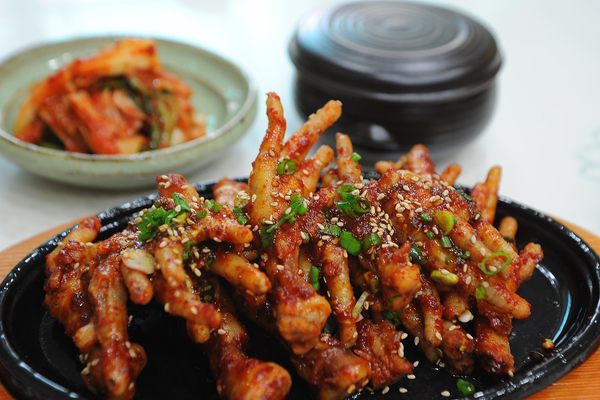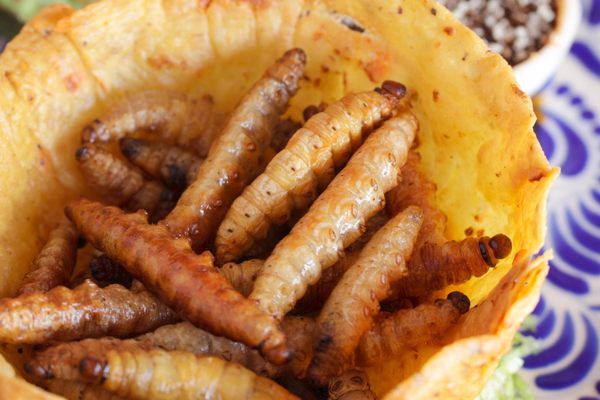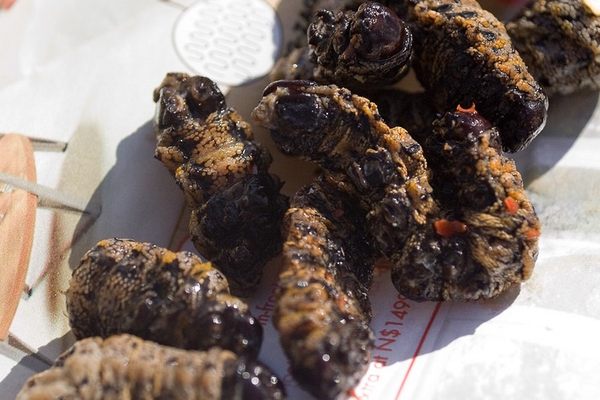Meats & Animal Products
Beondegi
In South Korean markets, steamed silkworm pupae make a juicy, nutty snack.
Walk through a market in South Korea, and you’ll likely detect a tangy, seafood-like smell coming from many of the street food stands. If you take a glance into one of the deep pans, you might well find it filled with something that looks similar to coffee beans. The steaming hiss sounds a bit like vegetables cooking. Despite its initial impression, beondegi isn’t a kind of fish, bean, or plant. It’s actually a type of insect—silkworm pupae, to be exact.
Beondegi makes for a popular snack food, sold on streets and in grocery stores all around South Korea. In its typical boiled or steamed form, it is savory and acidic, with a bit of a fishy, nutty flavor. Its outer shell is crunchy, while the inside is soft and juicy. It’s common for vendors to add spices or salt while cooking. They also make a candied version with sugar.
Though some people are fond of silkworm pupae from the first bite, many people find beondegi to be more of an acquired taste. It first became popular as a wartime food during the Korean War, since its excellent nutritional value and wide availability were helpful to people in need of a stable supply of protein. Silkworms had already been common in Korea for many generations, thanks to their role in creating silk, so it was easy to turn to them for a food source, as well.
Eventually, beondegi became ubiquitous, and it remains so today, though it tends to be most popular among older generations.
Where to Try It
-
Namdaemun Market
21, Namdaemunsijang 4-gil, Jung-gu, Seoul, 04529, South KoreaThis large market sells clothing, souvenirs, and food, including beondegi.
-
E-Mart Supermarket
400 Cheonggyecheon-ro, Hwanghak-dong, Jung-gu, South KoreaE-Mart is one of the major retailers that carries beondegi in its stores all around the country.
Written By
a andreamacgSources
- books.google.com/books?id=9XCjAQAAQBAJ&pg=PA320#v=onepage&q&f=false
- books.google.com/books?id=CBGpBAAAQBAJ&pg=PA267&dq=%22silkworm+pupae%22+korea&hl=en&sa=X&ved=0ahUKEwiN-KLdrZHZAhUMyFkKHVhlDJkQ6AEIJzAA#v=onepage&q=%22silkworm%20pupae%22%20korea&f=false
- books.google.com/books?id=K_pUCgAAQBAJ&pg=PA42&dq=%22silkworm+pupae%22+korea&hl=en&sa=X&ved=0ahUKEwiN-KLdrZHZAhUMyFkKHVhlDJkQ6AEISjAG#v=onepage&q=%22silkworm%20pupae%22%20korea&f=false
- archive.org/details/youtube-24u8CuJyRFw
- themagicelephant.wordpress.com/2015/06/04/25/
- 500sandwiches.com/post/65327257726/crunchy-silkworm-pupae
- www.hostelworld.com/blog/the-50-weirdest-foods-from-around-the-world/















